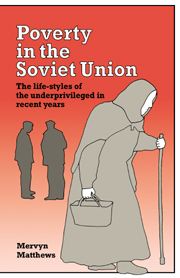Book contents
- Frontmatter
- Contents
- Preface
- PART I
- 1 IS THERE POVERTY IN THE SOVIET UNION?
- 2 WHO ARE THE SOVIET POOR?
- 3 POVERTY LIFE-STYLES: FOOD, CLOTHING, SHELTER
- PART II
- Postscript: Twelve theses on Soviet poverty
- Appendix 1 Samizdat and other unofficial documents
- Appendix 2 The emigre survey
- Notes
- Bibliography
- Index
2 - WHO ARE THE SOVIET POOR?
from PART I
Published online by Cambridge University Press: 30 October 2009
- Frontmatter
- Contents
- Preface
- PART I
- 1 IS THERE POVERTY IN THE SOVIET UNION?
- 2 WHO ARE THE SOVIET POOR?
- 3 POVERTY LIFE-STYLES: FOOD, CLOTHING, SHELTER
- PART II
- Postscript: Twelve theses on Soviet poverty
- Appendix 1 Samizdat and other unofficial documents
- Appendix 2 The emigre survey
- Notes
- Bibliography
- Index
Summary
Poverty in any land can only be considered with reference to the people afflicted by it. We shall now review the social and occupational groups whose per capita income is low enough to make poverty, as defined in Chapter One, highly likely for them. The social groups comprise families whose income is inadequate to cover dependent members, certain categories of pensioners and self-supporting individuals. The occupational groups, on the other hand, contain toilers whose jobs would not ordinarily pay enough to lift a family out of the poverty state. This means, in effect, that we need to review most common occupations in the lower reaches of the wage structure.
We shall consider as ‘low-paid’ only persons who are mature, and have achieved at least something like an average qualification in their chosen trade. Virtually all young workers and employees, not to mention apprentices and learners, are poor when they start: but they may expect to be well-paid in later life, so we shall, on the whole, omit them from our generalisations.
Since censorship restrictions prevent the publication of wage and income distributions, either by branch of the economy, or throughout the country as a whole, we must limit ourselves, in most cases, to illustrating published wage rates, or (when available) pensions and other per capita payments. It is worthy of note that the failure of the authorities to publish more than a smattering of data from the 1979 population census greatly complicates estimation of the size of the groups of people involved. We shall begin with a brief outline of how wages are fixed in the Soviet economy.
- Type
- Chapter
- Information
- Poverty in the Soviet UnionThe life-styles of the underprivileged in recent years, pp. 29 - 54Publisher: Cambridge University PressPrint publication year: 1986

